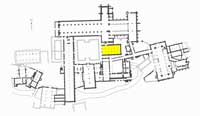 |
 |
 |
 |
 |
 |
 |
|
Fountains Abbey: History
Fountains Abbey: Buildings
|
The chapter-house at Fountains lay in the east range of the cloister. This was the typical location for a building of this kind, perhaps as it was one of the most inaccessible areas to outsiders and fairly well protected from the noise and bustle of daily life. The remains of the chapter-house belong to Abbot Richard’s impressive rebuilding, completed before his death in 1170. Richard was the first of many abbots to be buried here. This large, aisled building comprised of six bays and had three entrances to the cloister; the two westernmost bays could be screened off and used for storing books.(37) It was ornately decorated and was the first building at Fountains to use the grey Nidderdale marble, which would have made a striking contrast to the white lime-washed interior.(38) The chapter-house was a focal point of monastic life. It was here that the monks gathered for an hour each day to attend the chapter meeting, so called as proceedings began with the reading of a chapter from the Rule of St Benedict. The monks sat on wooden or stone benches around the walls. The abbot, or his deputy who presided in his place, occupied a pulpit in the eastern part of the room; there was also a lectern here for the reader. There were other occasions when the community gathered in the chapter-house, for example, to discuss business or to welcome a distinguished visitor; the entire community gathered here on feast days when the abbot delivered a sermon. Disciplinary matters were addressed in public in the chapter-house and punishment meted out, but monks might also come here to confess their sins in private to the prior. The chapter-house might also be used for reading or for copying manuscripts, when it was either too cold or too windy to do so in the cloister.(39) Reginald of Durham’s Life of Godric, describes how the monks of Fountains borrowed the Life of St Godric from the Durham community, to make their own copy. Out of veneration for the saint, it was decided to illuminate the text with bright colours, and the cantor (precentor) completes this skilful work in the chapter-house.(40) The chapter-house was a common place for the burial of abbots, especially before burial was permitted in the abbey church. Between 1170 and 1345, nineteen of the thirty-eight abbots who presided over Fountains were buried here.(41) In the late eighteenth century (1790-1791) the chapter-house was excavated to locate these graves, and the gardener’s digging recovered the graves of the abbots from Richard of Clairvaux (d. 1170) to William Rigton (d. 1346). Other notable persons may have been buried in the Fountains chapter-house, for example Turgisius, the former abbot of Kirkstall who retired to Fountains in the early thirteenth century, and important benefactors.(42) |
